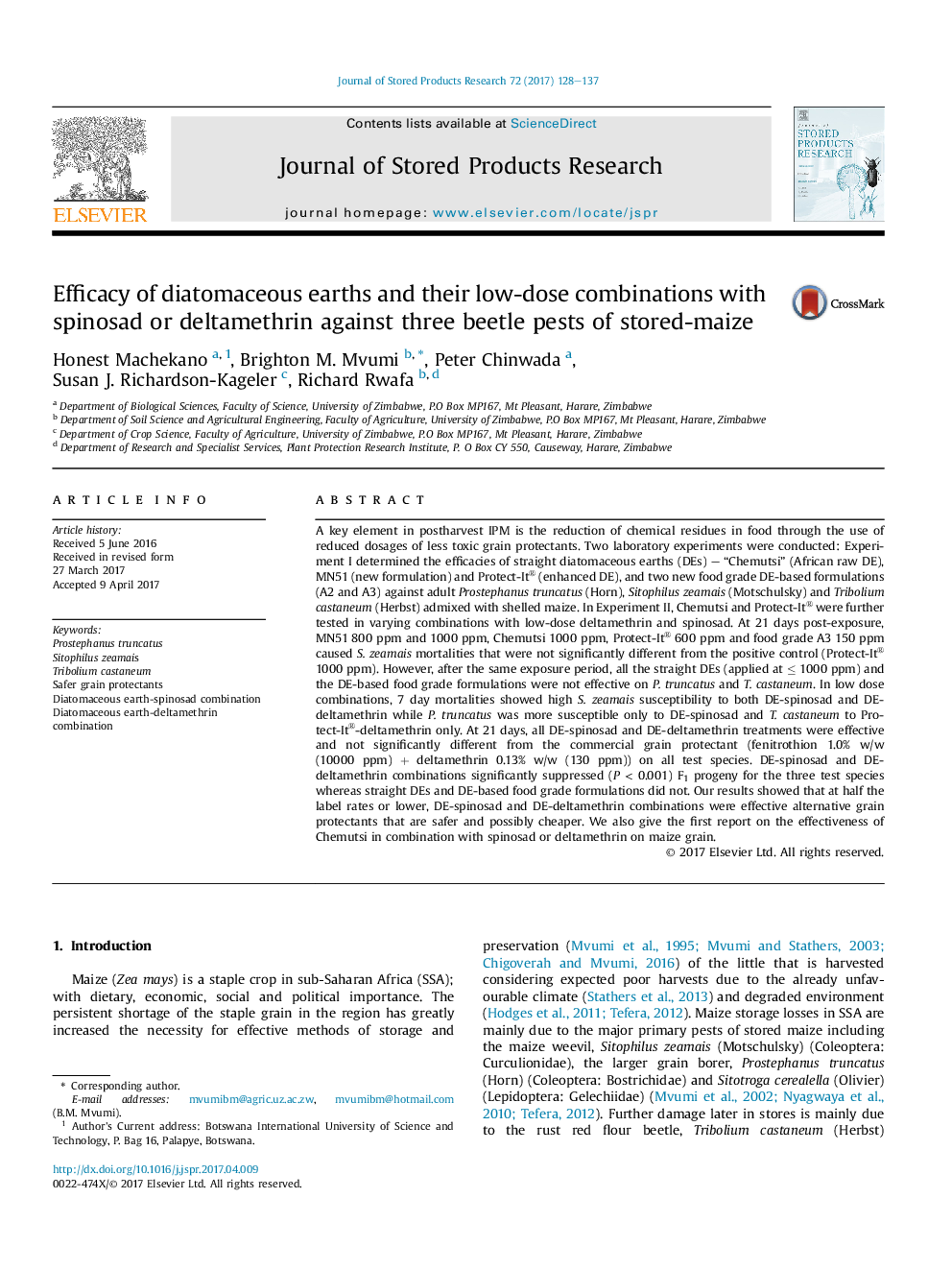| کد مقاله | کد نشریه | سال انتشار | مقاله انگلیسی | نسخه تمام متن |
|---|---|---|---|---|
| 5762569 | 1624917 | 2017 | 10 صفحه PDF | دانلود رایگان |
عنوان انگلیسی مقاله ISI
Efficacy of diatomaceous earths and their low-dose combinations with spinosad or deltamethrin against three beetle pests of stored-maize
ترجمه فارسی عنوان
اثربخشی زمینهای دیابتی و ترکیبات کم دوز آنها با اسپینوزاد یا دالتمترین علیه سه سوسک ذرت ذخیره شده
دانلود مقاله + سفارش ترجمه
دانلود مقاله ISI انگلیسی
رایگان برای ایرانیان
کلمات کلیدی
موضوعات مرتبط
علوم زیستی و بیوفناوری
علوم کشاورزی و بیولوژیک
علوم زراعت و اصلاح نباتات
چکیده انگلیسی
A key element in postharvest IPM is the reduction of chemical residues in food through the use of reduced dosages of less toxic grain protectants. Two laboratory experiments were conducted: Experiment I determined the efficacies of straight diatomaceous earths (DEs) - “Chemutsi” (African raw DE), MN51 (new formulation) and Protect-It® (enhanced DE), and two new food grade DE-based formulations (A2 and A3) against adult Prostephanus truncatus (Horn), Sitophilus zeamais (Motschulsky) and Tribolium castaneum (Herbst) admixed with shelled maize. In Experiment II, Chemutsi and Protect-It® were further tested in varying combinations with low-dose deltamethrin and spinosad. At 21 days post-exposure, MN51 800 ppm and 1000 ppm, Chemutsi 1000 ppm, Protect-It® 600 ppm and food grade A3 150 ppm caused S. zeamais mortalities that were not significantly different from the positive control (Protect-It® 1000 ppm). However, after the same exposure period, all the straight DEs (applied at â¤Â 1000 ppm) and the DE-based food grade formulations were not effective on P. truncatus and T. castaneum. In low dose combinations, 7 day mortalities showed high S. zeamais susceptibility to both DE-spinosad and DE-deltamethrin while P. truncatus was more susceptible only to DE-spinosad and T. castaneum to Protect-It®-deltamethrin only. At 21 days, all DE-spinosad and DE-deltamethrin treatments were effective and not significantly different from the commercial grain protectant (fenitrothion 1.0% w/w (10000 ppm) + deltamethrin 0.13% w/w (130 ppm)) on all test species. DE-spinosad and DE-deltamethrin combinations significantly suppressed (P < 0.001) F1 progeny for the three test species whereas straight DEs and DE-based food grade formulations did not. Our results showed that at half the label rates or lower, DE-spinosad and DE-deltamethrin combinations were effective alternative grain protectants that are safer and possibly cheaper. We also give the first report on the effectiveness of Chemutsi in combination with spinosad or deltamethrin on maize grain.
ناشر
Database: Elsevier - ScienceDirect (ساینس دایرکت)
Journal: Journal of Stored Products Research - Volume 72, May 2017, Pages 128-137
Journal: Journal of Stored Products Research - Volume 72, May 2017, Pages 128-137
نویسندگان
Honest Machekano, Brighton M. Mvumi, Peter Chinwada, Susan J. Richardson-Kageler, Richard Rwafa,
